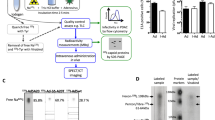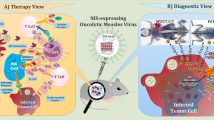Abstract
Purpose
Sindbis virus (SINV) infect tumor cells specifically and systemically throughout the body. Sindbis vectors are capable of expressing high levels of transduced suicide genes and thus efficiently produce enzymes for prodrug conversion in infected tumor cells. The ability to monitor suicide gene expression levels and viral load in patients, after administration of the vectors, would significantly enhance this tumor-specific therapeutic option.
Procedures
The tumor specificity of SINV is mediated by the 67-kDa laminin receptor (LR). We probed different cancer cell lines for their LR expression and, to determine the specific role of LR-expression in the infection cycle, used different molecular imaging strategies, such as bioluminescence, fluorescence molecular tomography, and positron emission tomography, to evaluate SINV-mediated infection in vitro and in vivo.
Results
All cancer cell lines showed a marked expression of LR. The infection rates of the SINV particles, however, differed significantly among the cell lines.
Conclusion
We used novel molecular imaging techniques to visualize vector delivery to different neoplatic cells. SINV infection rates proofed to be not solely dependent on cellular LR expression. Further studies need to evaluate the herein discussed ways of cellular infection and viral replication.







Similar content being viewed by others
References
Tseng JC, Levin B, Hirano T, Yee H, Pampeno C, Meruelo D (2002) In vivo antitumor activity of sindbis viral vectors. J Natl Cancer Inst 94:1790–1802
Tseng J, Levin B, Hurtado A, Yee H, Perez de Castro I, Jimenez M et al (2004) Systemic tumor targeting and killing by Sindbis viral vectors. Nat Biotechnol 22:70–77
Wang K, Kuhn RJ, Strauss EG, Ou S, Strauss JH (1992) High-affinity laminin receptor is a receptor for Sindbis virus in mammalian cells. J Virol 66:4992–5001
Liebman JM, Burbelo PD, Yamada Y, Fridman R, Kleinman HK (1993) Altered expression of basement-membrane components and collagenases in ascitic xenografts of OVCAR-3 ovarian cancer cells. Int J Cancer 55:102–109
Ozaki I, Yamamoto K, Mizuta T, Kajihara S, Fukushima N, Setoguchi Y et al (1998) Differential expression of laminin receptors in human hepatocellular carcinoma. Gut 43:837–842
Sanjuan X, Fernandez P, Miquel R, Munoz J, Castronovo V, Menard S et al (1996) Overexpression of the 67-kD laminin receptor correlates with tumour progression in human colorectal carcinoma. J Pathol 179:376–380
van den Brule FA, Berchuck A, Bast R, Liu FT, Gillet C, Sobel ME et al (1994) Differential expression of the 67-kD laminin receptor and 31-kD human laminin-binding protein in human ovarian carcinomas. Eur J Cancer 30A(8):1096–1099
Balachandran S, Roberts PC, Kipperman T, Bhalla KN, Compans RW, Archer DR et al (2000) Alpha/beta interferons potentiate virus-induced apoptosis through activation of the FADD/Caspase-8 death signaling pathway. J Virol 74:513–1523
Levine B, Huang Q, Isaacs JT, Reed JC, Griffin DE, Hardwick JM (1993) Conversion of lytic to persistent alphavirus infection by the bcl-2 cellular oncogene. Nature 361:739–742
Zrachia A, Dobroslav M, Blass M, Kazimirsky G, Kronfeld I, Blumberg PM et al (2002) Infection of glioma cells with Sindbis virus induces selective activation and tyrosine phosphorylation of protein kinase C delta. Implications for Sindbis virus-induced apoptosis. J Biol Chem 277:23693–23701
Caruso M, Panis Y, Gagandeep S, Houssin D, Salzmann JL, Klatzmann D (1993) Regression of established macroscopic liver metastases after in situ transduction of a suicide gene. Proc Natl Acad Sci U S A 90:7024–7028
Mar EC, Chiou JF, Cheng YC, Huang ES (1985) Human cytomegalovirus-induced DNA polymerase and its interaction with the triphosphates of 1-(2′-deoxy-2′-fluoro-beta-d-arabinofuranosyl)-5-methyluracil, -5-iodocytosine, and -5-methylcytosine. J Virol 56:846–851
Beltinger C, Fulda S, Kammertoens T, Uckert W, Debatin KM (2000) Mitochondrial amplification of death signals determines thymidine kinase/ganciclovir-triggered activation of apoptosis. Cancer Res 60:3212–3217
Beltinger C, Fulda S, Kammertoens T, Meyer E, Uckert W, Debatin KM (1999) Herpes simplex virus thymidine kinase/ganciclovir-induced apoptosis involves ligand-independent death receptor aggregation and activation of caspases. Proc Natl Acad Sci U S A 96:8699–8704
Serganova I, Doubrovin M, Vider J, Ponomarev V, Soghomonyan S, Beresten T et al (2004) Molecular imaging of temporal dynamics and spatial heterogeneity of hypoxia-inducible factor-1 signal transduction activity in tumors in living mice. Cancer Res 64:6101–6108
Tjuvajev JG, Finn R, Watanabe K, Joshi R, Oku T, Kennedy J et al (1996) Noninvasive imaging of herpes virus thymidine kinase gene transfer and expression: a potential method for monitoring clinical gene therapy. Cancer Res 56:4087–4095
Anderson H, Pillarsetty N, Cantorias M, Lewis JS (2010) Nucl Med Biol 37:439–442
Ntziachristos V, Schellenberger EA, Ripoll J et al (2004) Visualization of antitumor treatment by means of fluorescence molecular tomography with an annexin V-Cy5.5 conjugate. PNAS 101(33):12294–12299
Ntziachristos V, Tung CH, Bremer C et al (2002) Fluorescence molecular tomography resolves protease activity in vivo. Nature Med 8(7):757–760
Jamieson KV, Wu J, Hubbard SR, Meruelo D (2008) Crystal structure of the human laminin receptor precursor. J Biol Chem 6:3002–3005
Nelson J, McFerran NV, Pivato G, Chambers E, Doherty C, Steele D et al (2008) The 67kDa laminin receptor: structure, function and role in disease. Biosc Rep 28:33–48
Lundstrom K (2005) Biology and application of alphaviruses in gene therapy. Gene Ther 12:S92–S97
Nanda K, Vancini R, Ribeiro M, Brown DT, Hernandez R (2009) A high capacity Alphavirus heterologous gene delivery system. Virology 390:368–373
Tseng JC, Hurtado A, Yee H, Levin B, Boivin C, Benet M et al (2004) Using sindbis viral vectors for specific detection and suppression of advanced ovarian cancer in animal models. Cancer Res 64:6684–6692
Tseng JC, Zanzonico PB, Levin B, Finn R, Larson SM, Meruelo D (2006) Tumor-specific in vivo transfection with HSV-1 thymidine kinase gene using a Sindbis Viral vector as a basis for prodrug ganciclovir activation and PET. J Nucl Med 47:1136–1143
Kurkela S, Manni T, Myllynen J, Vaheri A, Vapalahti O (2005) Clinical and laboratory manifestations of sindbis virus infection: prospective study, Finland, 2002–2003. J Infect Dis 191:1820–1829
Scheiman J, Tseng JC, Zheng Y, Meruelo D (2010) Multiple functions of the 37/67-kd laminin receptor make it a suitable target for novel cancer gene therapy. Mol Ther 18:63–74
Scheiman J, Jamieson KV, Ziello J, Tseng JC, Meruelo D (2010) Extraribosomal functions associated with the C terminus of the 37/67kDa laminin receptor are acquired for maintaining cell viability. Cell Death Dis 1:e42
Hand PH, Thor A, Schlom J, Rao CN, Liotta L (1985) Expression of laminin receptor in normal and carcinomatous human tissues as defined by a monoclonal antibody. Cancer Res 45:2713–2719
Ryman KD, Gardner CL, Burke CW, Meier KC, Thompson JM, Klimstra WB (2007) Heparan sulfate binding can contribute to the neurovirulence of neuroadapted and nonneuroadapted sindbis viruses. J Virol 81:3563–3573
Klimstra WB, Ryman KD, Johnston RE (1998) Adaptation of Sindbis virus to BHK cells selects for use of heparan sulfate as an attachment receptor. J Virol 72:7357–7366
Rowell JF, Griffin DE (1999) The inflammatory response to nonfatal Sindbis virus infection of the nervous system is more severe in SJL than in BALB/c mice and is associated with low levels of IL-4 mRNA and high levels of IL-10-producing CD4+ T cells. J Immunol 162:1624–1632
Bear JS, Byrnes AP, Griffin DE (2001) Heparin-binding and patterns of virulence for two recombinant strains of Sindbis virus. Virology 347:183–190
Granot T, Venticinque L, Tseng J-C, Meruelo D (2010) Activation of cytotoxic and regulatory functions of NK cells by Sindbis viral vectors. PLoS One 6:e20598
Li C, Gu Y, Andrade D, Liu Y (2009) Susceptibility of colorectal cancer cells to Sindbis virus infection. J Exp Ther Oncol 8:167–175
De Vries W, Haasnot J, van der Velden J, van Montfort T, Zorgdrager F, Paxton W et al (2008) Increased virus replication in mammalian cells by blocking intracellular innate defense responses. Gene Ther 15:545–552
Hayman A, Comely S, Lackenby A, Murphy S, McCauley J, Goodbourn S et al (2006) Variation in the ability of human influenzy A viruses to induce and inhibit the IFN-ß pathway. Virology 347:52–64
Myles KM, Wiley MR, Morazzani EM, Adelman ZN (2008) Alphavirus-derived small RNAs modulate pathogenesis in disease vector mosquitoes. Proc Natl Acad Sci U S A 105:19938–19943
Orvedahl A, MacPherson S, Sumpter R, Talloczy Z, Zou Z, Levine B (2010) Autophagy protects against Sindbis virus infection of the central nervous system. Cell Host Microbe 7:115–127
Mizushima N, Levine B, Cuervo AM, Klionsky DJ (2008) Autophagy fights disease through cellular self-digestion. Nature 451:1069–1075
Ke PY, Chen SS (2011) Activation of the unfolded protein response and autophagy after hepatitis C virus infection suppresses innate antiviral immunity in vitro. J Clin Invest 121:37–56
Tseng JC, Granot T, DiGiacomo V, Levin B, Meruelo D (2010) Enhanced specific delivery and targeting of oncolytic Sindbis viral vectors by modulating vascular leakiness in tumor. Cancer Gene Ther 17:244–255
Acknowledgments
We thank the staff of the Radiochemistry/Cyclotron Core at MSKCC. Technical services provided by the MSKCC Small-Animal Imaging Core Facility were supported in part by NIH grants R24 CA83084 and P30 CA08748. Technical services provided by the MSKCC Small-Animal Imaging Core Facility were supported in part by the NIH (R24 CA83084 and P30 CA08748). Lars Stelter was supported by the Deutsche Forschungsgemeinschaft (Ste 1837/1-1). Steven M. Larson was supported by the Ludwig Center for Cancer Immunotherapy at MSKCC and the National Cancer Institute (P50-CA86483).
Conflict of Interest
The contents of this study are being used for a patent. According to the rules and regulations of New York University School of Medicine, if this patent is licensed by a third party, some of the authors (JT, BL, and DM) may receive benefits in the form of royalties or equity participation. All other authors declare that they have no conflict of interest.
Author information
Authors and Affiliations
Corresponding author
Rights and permissions
About this article
Cite this article
Stelter, L., Tseng, JC., Torosjan, A. et al. Tumor-Specific Targeting With Modified Sindbis Viral Vectors: Evaluation with Optical Imaging and Positron Emission Tomography In Vivo . Mol Imaging Biol 15, 166–174 (2013). https://doi.org/10.1007/s11307-012-0585-8
Published:
Issue Date:
DOI: https://doi.org/10.1007/s11307-012-0585-8




